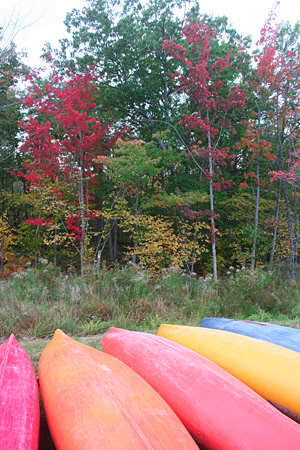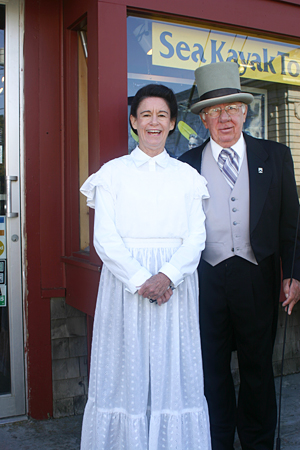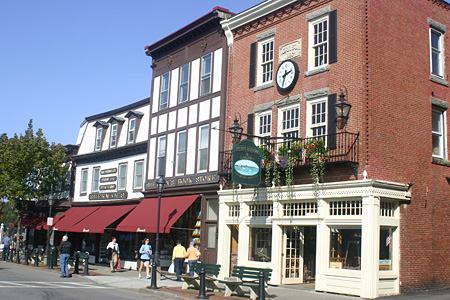The new version of Workamper.com is...
Read moreWorkamping is a Ticket to Travel
Workamping is a Ticket to Travel
 Workamping is a ticket to unexplored places and new experiences. Notice I didn’t say a “free” ticket. Sometimes, you have to pay your way. That’s exactly what my photographer husband, Lee Smith, and I did to spend six weeks in the midst of Maine’s spectacular autumn.
Workamping is a ticket to unexplored places and new experiences. Notice I didn’t say a “free” ticket. Sometimes, you have to pay your way. That’s exactly what my photographer husband, Lee Smith, and I did to spend six weeks in the midst of Maine’s spectacular autumn.
When we read Glenn Tucker’s bid for immediate help at Coastal Kayaking/Acadia Bike in Bar Harbor, I noted that was a place I’d like to spend the fall. However, his ad appeared on the Workamper Hot Line in mid-August, and we had commitments through mid September. I sent an inquiry, remembering the Workamper’s motto: It never hurts to ask! To my surprise, Mr. Tucker replied saying their season runs until the end of October due to cruise ships arriving in their harbor and providing his company with customers. He welcomed our arrival in the middle of September. We did some quick figuring and decided we could make the trip and barely break even financially for five weeks of employment.
We drove on to Mount Desert Island on September 16 and found our designated campground at Southwest Harbor, one of several villages on the island. Mr. Tucker had arranged our accommodations in a wooded campsite next to two other Workamping couples. He paid half our monthly rent. We reported to work the next morning at 8:00.
However, we couldn’t wait to get our bearings in the place that we’d call home for the next few weeks. On our first afternoon, we traced our 30-minute route from the campground into Bar Harbor. Both a town and a village, the charming Maine fishing village with a history of attracting rich folks in the early 1900s, accommodates today’s tourists with lodgings, restaurants, activities, and shops. We found Coastal Kayaking/Acadia Bike on Cottage Street.
Situated on Frenchman’s Bay, the mountains of Acadia National Park surround Bar Harbor on three sides. Remnants of the so-called cottages of the rich line the harbor’s coast and dot the small town; most of the stately mansions now converted to inns. Many of the two and three-story houses succumbed to a devastating fire in 1947. Others were torn down after the national income tax prohibited their costly maintenance.
On our first day at work, a gentleman in a formal morning frock with tails and top hat greeted us in a pronounced South Carolina drawl. His wife, attired in a long dress and white apron, also welcomed us. These co-workers, Billy and Molly Nettles, guided Victorian walking tours around town for clients arriving on the cruise ships. They immediately began training me for customer service behind the counter. Another co-worker, Becky Schmidt, arrived, and she, too, provided patient training for renting bicycles and booking kayak tours. We entered the customer’s information on computers, and provided a print-out for them to take to the adjoining bicycle shop where attendants fitted them with bicycles and helmets.
 A fast work pace spun me through the first day, filling my head with new information. I listened to co-workers explain to customers how to get to the Carriage Roads of Acadia National Park. Yet for the first few days, I had no visual picture of what I repeated. Molly and Billy had worked for the company for six years, and Becky and Steve, who was a driver working with Lee, had worked for three seasons. They were all as knowledgeable as locals in getting around Mount Desert Island and Bar Harbor.
A fast work pace spun me through the first day, filling my head with new information. I listened to co-workers explain to customers how to get to the Carriage Roads of Acadia National Park. Yet for the first few days, I had no visual picture of what I repeated. Molly and Billy had worked for the company for six years, and Becky and Steve, who was a driver working with Lee, had worked for three seasons. They were all as knowledgeable as locals in getting around Mount Desert Island and Bar Harbor.
Before the first day ended, I entered some customer orders for bike rentals and ran their credit cards through the machine. The shop also had retail in tee shirts, sun glasses, and jackets. That first day, we rented approximately 100 bicycles, but my co-workers noted that busy summer days generated twice or three times that many. To book kayak tours, we were required to give each customer certain cancellation policies and information about proper clothing for comfort.
Typically, each day scheduled a morning harbor tour, one or two coastal tours, and a sunset tour. The business, even in the fall shoulder season, remained busy with a constant flow of people renting bikes and booking tours. The phone rang frequently with callers needing information about the company’s services or wanting to reserve bicycles or kayak tours. The pace slowed in early afternoon, but before 3:00, customers started checking in their bikes, and we were busy again.
On the other hand, Lee immediately went to the Depot, an area about a mile from the downtown shop where the kayaks, bus, and vans were stored. Trained by Steve Schmidt, he started driving vans that pulled trailers of kayaks to launching points around the island. He, too, listened to guides and other Workamper drivers to learn about Mount Desert Island’s history and geography. His knowledge of the island quickly surpassed what I gained standing behind the shop’s counter all day.
Tucker Enterprises, the umbrella name for Glenn Tucker’s business, contracted, not only with cruise ships, but with Elderhostel groups for transportation and guides for hiking, biking, and kayaking tours. Lee shuttled numerous groups to trailheads. The company also owned a limousine and Tucker offered private tours of the island. At a sister store a few blocks down Cottage Street, he rented scooters and individual kayaks. Often the scooter rentals were processed through our store.
After working several days, Lee and I had a day off to explore on our own. We picked up a couple of mountain bikes at the shop, one of the bonuses of our work contract, and headed for the Carriage Roads. John D. Rockefeller, Jr. built over 45 miles of well-engineered crushed stone roads and donated them to Acadia National Park, designating the roads forever for the use of hikers, bikers, and horses only.
The hard-packed roads wind up and down through deep forests and alongside natural lakes carved centuries ago by glaciers. Our first time on the roads, Lee and I biked a recommended loop around Eagle Lake and Jordan Pond, stopping for a leisurely lunch at Jordan Pond House, a restaurant famous for its popovers and tea. Originally serving park guests on the lawn of an old farm house, the restaurant offers a full menu of fresh seafood, including Maine’s famed lobsters.
 On time off, we also drove the Park Loop Road and wound our way up Cadillac Mountain to view the setting sun. After a few excursions, I became more comfortable in telling customers about places to visit in Acadia National Park. We visited the other towns and villages on the Island, admiring the rugged coastline, the fishing docks, and New England architecture. Each morning on our way to work, we drove through the village of Somesville, founded by the island’s first settlers. Rimming the head of Somes Sound, a fiord slicing into the center of the island, the picturesque village has deed restrictions for maintaining all residences in white siding with black shutters. Our morning and evening commute to Bar Harbor took us past thick hardwood forests. For several weeks, we watched autumn paint the trees in bright gold, red, and yellow, and then gently blow away the leaves.
On time off, we also drove the Park Loop Road and wound our way up Cadillac Mountain to view the setting sun. After a few excursions, I became more comfortable in telling customers about places to visit in Acadia National Park. We visited the other towns and villages on the Island, admiring the rugged coastline, the fishing docks, and New England architecture. Each morning on our way to work, we drove through the village of Somesville, founded by the island’s first settlers. Rimming the head of Somes Sound, a fiord slicing into the center of the island, the picturesque village has deed restrictions for maintaining all residences in white siding with black shutters. Our morning and evening commute to Bar Harbor took us past thick hardwood forests. For several weeks, we watched autumn paint the trees in bright gold, red, and yellow, and then gently blow away the leaves.
Over the course of our stay, we frequented local restaurants and indulged in lobster, scallops, and haddock. We toured Abbe Museum to explore Maine Native American cultures, history, and archeology. Because we were employed in Bar Harbor, we enjoyed a complimentary excursion aboard the Margaret Todd, a 4-Masted historic schooner. We toured the Wild Gardens of Acadia and made a stop at the park’s Visitor Center.
We tramped over a trail to the remains of the home of George Door, considered the Father of Acadia for his dedication to acquiring the donation of lands to create the park. One day, we drove to the opposite side of Frenchman’s Bay to Schoodic Peninsula, the only portion of Acadia National Park found on the mainland.
During my work day lunch break, I often walked to the park at the harbor or the Village Green. Some days, I browsed the interesting shops along the quaint and busy streets of Bar Harbor. Every day brought interesting people to the shop to rent bicycles or take kayak tours.
If we had gone to Bar Harbor earlier in the season, we could have hiked more trails, taken more boat excursions, and possibly, eaten more lobster. However, in the six weeks we lived and worked on Mount Desert Island, we experienced the beauty and wildness of Acadia National Park, worked with great people, and watched the beauty of autumn come and go. Workamping provided the ticket for this opportunity.


